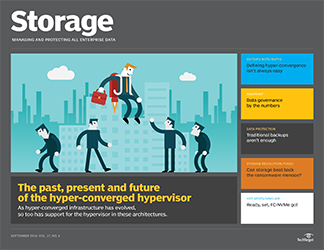- Share this item with your network:
- Download
Storage

Torbz - Fotolia
Three approaches to strategic data management: Good, better and best
It's time organizations take a more mature and sophisticated approach to data management techniques and make the most of the data they generate and consume.
In a vlog earlier this year, I spoke of the concept of "Y" and how data protection must evolve toward data availability and data management. Regarding the latter, it is time for organizations, and vendors, to take a more sophisticated approach to managing their data. To get the maximum benefit from this important resource, I suggest using what I call the good, better and best approaches to strategic data management.
Good. Keep data for as long as it's needed. This may sound fundamental, but many organizations only hold data for six months or a year. As such, they may not be able to roll back their data as far as needed when the situation requires it, for example, when told to retrieve historical data during an e-discovery event or regulatory audit.
Some organizations also don't protect data frequently enough -- perhaps only once or twice per week -- which can result in more data loss than is tolerable when recovering from a malware attack or other corruption event. One vendor refers to this as the "protection gap" between what business units expect in data recoverability and what IT is able to deliver.
Bottom line: Good strategic data management requires a modern approach to data backup and recognition by senior management of the importance of data retention and recovery.
Better. Keep what you need and get rid of what you don't. As soon as many organizations have "solved" their data retention issues -- keeping data as long as they should for compliance reasons and backing up as often as necessary -- they discover the storage burdens associated with doing so. Similarly, as soon as you satisfy lawyers and compliance teams that you're keeping data long enough, they will amend their requests with "and not one day more." Data destruction is as important a facet of data management as data retention.
Your data protection budget would appreciate it if you removed or destroyed data that has been sitting in storage longer than its mandated retention window dictates. Previous versions of data used for operational purposes aren't useful after 18 months to 24 months. Yet a minority of your data likely has strategic or regulatory requirements warranting five or more years of retention.
Bottom line: Better strategic data management requires the use of archiving technologies, as well as improved communication and collaboration between compliance teams and IT professionals. You have to stop thinking about backups in terms of blind copies of folders, databases or other data containers. Start acting with contextual insight regarding what information is contained in the data.
Best. Do more with protection and preservation copies than just restoration. Backups, archives, snapshots, replicas and so on each have their own purpose, but implementing a modern data protection infrastructure can get expensive. What else could you do with the dormant data within those repositories? Consider the following:
- Boot up a dormant remote copy for business continuity and disaster recovery.
- Update a copy of an operating system or application in a test environment to ensure that a new OS patch or application update won't negatively affect your users when they're actually implemented in the production environment.
- Run analytics or reporting on dormant data to gain new insights without affecting production performance.
- Provide DevOps with a near-live copy of production data to accelerate its efforts, and thereby accelerate the organization.
Those are just a few potential scenarios. You should ask yourself what additional capabilities and business value you could achieve by leveraging the otherwise dormant data within protection storage.
Bottom line: To gain the best in strategic data management means embracing what the industry terms copy data management (CDM), sometimes referred to as copy data virtualization or active copy management. Some vendor approaches start with copy enablement, where data protection is just one of the outcomes. Other vendors augment their core data protection offerings with mechanisms similarly intended to provide new operational capabilities such those listed earlier.
There is a lot of warranted excitement and focus, as well as some hype, in the area of CDM. But make no mistake, data protection and preservation are becoming foundational elements of a broader data management strategy. This strategy allows you to not only keep what you need and remove what you don't, but to do more with the data you have.
Next Steps
Sarbanes-Oxley Act data retention best practices
Study finds one-third of companies lack data retention and security policies



























